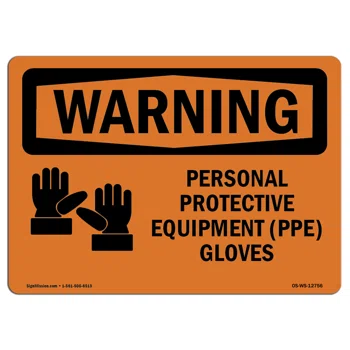If you are not wearing the right protection your hands could be burned, frozen, cut, scraped or burned by chemicals. You could lose fingers, a thumb, or even your life. That is why you wear gloves.
To protect your hands your gloves must fit properly.
If they are too tight then you will fight to get your fingers to work their way into the gloves. Circulation could be restricted if the gloves are too tight. If the gloves are too loose then you won’t be able to grip properly and you could risk getting trapped at a pinch point.
Different materials offer different protection, and of course they should be replaced when worn or damaged. Below are different material gloves are made from and their associated hazard protection;
1) Cotton: Is cheap, reusable and absorbs sweat. It is not long-lasting, however, and offers little protection from severe hazards.
2) Leather: Resists punctures, abrasion, sparks, and impact, but has limited dexterity and cut resistance.
3) Rubber: Natural rubber, nitrile, and PVC gloves are best for chemical resistance but offer limited heat and cut defense.
4) Metal: Metal-reinforced gloves and newer fibres such as Kevlar are lightweight and resist cuts well. Some fibres also resist heat.
Many tasks require specific hand protection. Welding and chemical hazards require long gloves, but the material should be matched to the activity and hazard.
1) Abrasives: Severe hazard: Use reinforced heavy rubber or staple-reinforced leather
– Less severe: rubber, plastic, leather, nylon and cotton
2) Sharp Edges: Severe hazard: metal mesh, staple reinforced leather, Kevlar or steel mesh
– Less severe: leather or terry cloth
3) Temperature: Severe Cold: Rubber or fibre insulated gloves
– Mild Cold: Wool or cotton
– Mild Heat: Rubber, leather, heavy cotton
– High Heat: Leather, metal or fibre gloves
4) Chemicals and Fluids: No material keeps out all chemicals. Choices include natural rubber, neoprene, nitrile rubber and many others. Ask your glove vendor for a chemical resistivity chart. The best information may be the material safety data sheet (MSDS) accompanying each chemical. Always check for glove defects. Rubber gloves can be filled with air or water looking for leaks.
Remember; protect your hands at all times. They are your most important instruments and cannot be replaced when damaged or destroyed. Even long term effects like Dermatitis or Arthritis can be limited due to proper care and protection of these precious tools.
HRS Group Inc. has a great team that can help you with all your health and safety needs including PPE. Contact Deborah toll free at 1-877-907-7744 or locally at 705-749-1259.
Remember In Ontario, “ALL Accidents are Preventable”
‘Work’ and ‘Play’ safe.
Daniel L. Beal
CHSEP – Foundation Level
VP & Senior Trainer
HRS Group Inc.


Thanks for the marvelous posting!
Thanks.
Thanks for the informative web site.
You are very welcome!
Write more, that’s all I have to say!
This is a good site!
Wow, awesome blog layout!
Thank you!
It’s difficult to find educated people discussing health and safety!
That is a really well written article.
Have a great day. Bye
Keep up posting such articles or reviews.
Hey There. I discovered your blog using msn. This is certainly a really well-written article.
I do agree with every one of the ideas you have offered in your post.
I really like this site!
Thank you for the kind words!
Daniel L. Beal
CHSEP – Advanced
Many thanks!